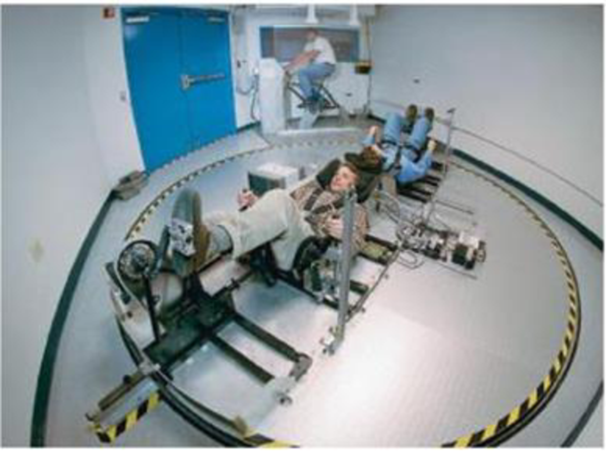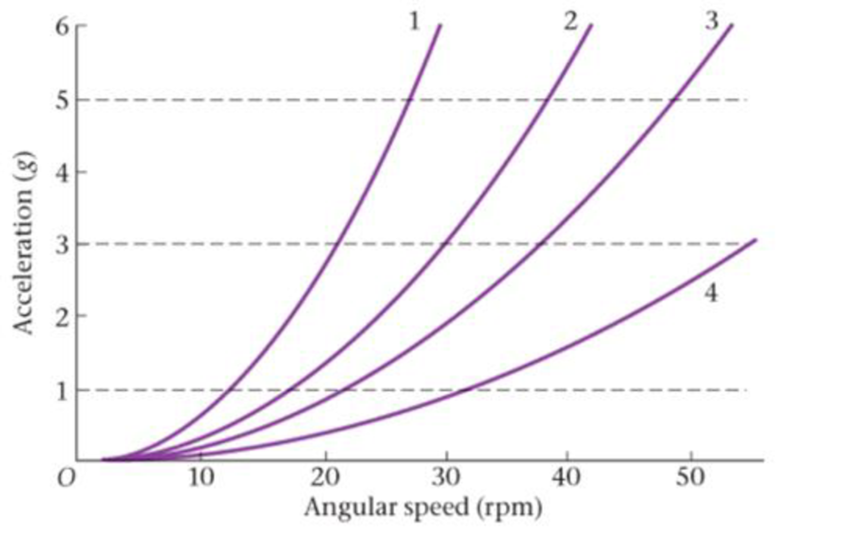
Concept explainers
BIO Human-Powered Centrifuge
Space travel is fraught with hazards, not the least of which are the many side effects of prolonged weightlessness, including weakened muscles, bone loss, decreased coordination, and unsteady balance. If you are fortunate enough to go on a trip to Mars, which could take more than a year each way, you might be a bit “weak in the knees” by the time you arrive. This could lead to problems when you try to take your first “small step” on the surface.
To counteract these effects, NASA is looking into ways to provide astronauts with “portable gravity” on long space flights One method under consideration is the human-powered centrifuge, which not only subjects the astronauts to artificial gravity, but also gives them aerobic exercise. The device is basically a rotating, circular platform on which two astronauts lie supine along a diameter, head-to-head at the center, with their feet at opposite rims, as shown in the accompanying photo. The radius of the platform in this test model is 6.25 ft. As one astronaut pedals to rotate the platform, the astronaut facing the other direction can exercise in the artificial gravity. Alternatively, a third astronaut on a stationary bicycle can provide the rotation for the other two. While the astronauts’ feet are at the outer rim of the platform, their heads are near the center of the platform, and their hearts are 4.50 feet from the rim, which means that different parts of the astronauts’ bodies will experience different “gravitational” accelerations.

Human-powered centrifuge.
Figure 10-43 shows the centripetal acceleration (in g) produced by a rotating platform at four different radii. Notice that the acceleration increases as the square of the angular speed. Also indicated in Figure 10-43 are acceleration levels corresponding to 1, 3, and 5 gs. It is thought that enhanced gravitational effects may be desirable because the astronauts will experience the artificial gravity for only relatively brief periods of time during the flight.

Figure 10-43
Problems 94, 95, 96, and 97
94 • Rank the four curves shown in Figure 10-43 in order of increasing radius. Indicate ties where appropriate.
Want to see the full answer?
Check out a sample textbook solution
Chapter 10 Solutions
Physics (5th Edition)
Additional Science Textbook Solutions
The Cosmic Perspective
Essential University Physics: Volume 1 (3rd Edition)
College Physics (10th Edition)
The Cosmic Perspective (8th Edition)
- For many years, astronomer Percival Lowell searched for a Planet X that might explain some of the perturbations observed in the orbit of Uranus. These perturbations were later explained when the masses of the outer planets and planetoids, particularly Neptune, became better measured (Voyager 2). At the time, however, Lowell had proposed the existence of a Planet X that orbited the Sun with a mean distance of 43 AU. With what period would this Planet X orbit the Sun?arrow_forward2arrow_forwardPRINTER VERSION 4 ВАСК NEXT Chapter 13, Problem 079 A certain triple-star system consists of two stars, each of mass m = 4.8×1030 kg, revolving in the same circular orbit of radius r = 3.2x1011 m about a central star of mass M = 6.9x1033 kg (the figure). The two orbiting stars are always at opposite ends of a diameter of the orbit. Calculate the period of revolution of the stars. Number Units the tolerance is +/-2% Click if you would like to Show Work for this question: Open Show Workarrow_forward
- A coin 20mg is place on the smooth edge of a 25 cm-radius phonograph record as the record is brought up to its normal rational speed of 45 rmp. What must be the coefficient of friction between the coin and the record if the coin is not to slip off? 0.56 0.64 0.45 0.78arrow_forwardAn exotic planet Vogsphere is known to have a mass that is 1/81 that of the Earth and a radius 0.25 that of the Earth. Astrophysicist Trillian built a rocket and decided to leave the planet and never to return. Given that the escape speed from the Earth is 11.2 km/s, with what speed must Trillian achieve his goal?arrow_forward4The free-fall acceleration on the surface of the Moon is about one-sixth that on the surface of the Earth. The radius of the Moon is about 0.250 R: (RE = radius of Earth = 6.37E6 m). Find the ratio of their average densities: pdoon/PEarth- (2/3) %3Darrow_forward
- Physics An intergalactic spaceship arrives at a distant planet that rotates on its axis with a period of T = 43 hours. The mass of the planet is M = 2.7 • 1025 kg. The spaceship enters a circular orbit with an orbital period that is equal to the planet's period for the rotation about its axis, T. Part a) Write an expression for the radius of the spaceship’s orbit R=? Part b) Calculate the orbital radius in metersarrow_forwardTwo uniform spheres are positioned as shown. Determine the gravitational force F which the titanium sphere exerts on the copper sphere. The value of R is 30 mm. Assume a = 3.7.b = 2.1,0-39° aR Titanium Part 1 Copper Incorrect Calculate the mass of each sphere. Assume a = 3.7,b=2.1,0-39. aR Titanium Answers: Titanium sphere m₂ = Copper sphere R Copper m₂ = i bR bR 1 kg 1 kgarrow_forward31. ssm The mass of a robot is 5450 kg. This robot weighs 3620 N more on planet A than it does on planet B. Both planets have the same radius of 1.33 × 10’ m. What is the difference M, – Mg in the masses of these planets?arrow_forward
- The planet Mars has a radius of 3,390 km. The value of g (free fall acceleration) at the surface of Mars is 3.71 m/s2. (a) Estimate the mass of Mars, in kg. (b) Estimate the value of g at a height of 1,750 km above the surface of Mars.arrow_forwardGQ6arrow_forwarddensity is A planet has twice the radius but the mean as compared to earth. What is ratio of the Escape velocity from earth to that from the planet. #*4arrow_forward
 Physics for Scientists and Engineers: Foundations...PhysicsISBN:9781133939146Author:Katz, Debora M.Publisher:Cengage Learning
Physics for Scientists and Engineers: Foundations...PhysicsISBN:9781133939146Author:Katz, Debora M.Publisher:Cengage Learning Principles of Physics: A Calculus-Based TextPhysicsISBN:9781133104261Author:Raymond A. Serway, John W. JewettPublisher:Cengage Learning
Principles of Physics: A Calculus-Based TextPhysicsISBN:9781133104261Author:Raymond A. Serway, John W. JewettPublisher:Cengage Learning Physics for Scientists and Engineers, Technology ...PhysicsISBN:9781305116399Author:Raymond A. Serway, John W. JewettPublisher:Cengage Learning
Physics for Scientists and Engineers, Technology ...PhysicsISBN:9781305116399Author:Raymond A. Serway, John W. JewettPublisher:Cengage Learning Classical Dynamics of Particles and SystemsPhysicsISBN:9780534408961Author:Stephen T. Thornton, Jerry B. MarionPublisher:Cengage Learning
Classical Dynamics of Particles and SystemsPhysicsISBN:9780534408961Author:Stephen T. Thornton, Jerry B. MarionPublisher:Cengage Learning Physics for Scientists and Engineers with Modern ...PhysicsISBN:9781337553292Author:Raymond A. Serway, John W. JewettPublisher:Cengage Learning
Physics for Scientists and Engineers with Modern ...PhysicsISBN:9781337553292Author:Raymond A. Serway, John W. JewettPublisher:Cengage Learning Physics for Scientists and EngineersPhysicsISBN:9781337553278Author:Raymond A. Serway, John W. JewettPublisher:Cengage Learning
Physics for Scientists and EngineersPhysicsISBN:9781337553278Author:Raymond A. Serway, John W. JewettPublisher:Cengage Learning





